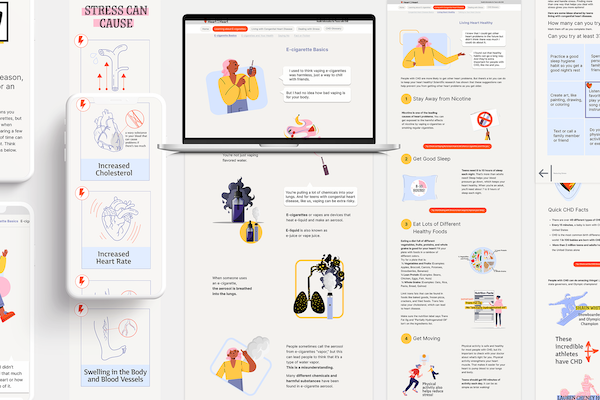Yvette Shen and Jeremy Patterson Work to Develop Anti-Vaping Program for Teens with Congenital Heart Disease

Associate professor Yvette Shen and Jeremy Patterson, Graphics Researcher and Instructor at ACCAD, are working on an anti-vaping program directed towards teens with congenital heart disease (CHD). The program takes the form of an interactive infographic story designed specifically to improve health literacy among young people with CHD.
The prevalence of vaping in young people is shocking with more than 1 million high school students reported as currently using e-cigarettes along with more than 400,000 middle school students (Centers for Disease Control and Prevention).
“Teens with CHD face higher health risks from vaping than their peers, yet many don’t fully understand how it affects their condition” says Shen. She believes the interactive and engaging nature of the program “meets a real need: helping a vulnerable group make informed choices that can directly affect their long-term health”.
According to Shen, one of the main factors behind the project’s success was the early integration of designers. Rather than adjusting their approach to fit a predetermined plan (something many designers must do), Shen and Patterson were able to use their specific expertise to develop the plan alongside healthcare professionals from Nationwide Children’s Hospital.
“We were able to work as a team through the format, tone, visual style, content, and what the platform actually needed to accomplish before anything was locked in. The process was very collaborative” says Shen.
Naturally, challenges arose in the process of developing potential ideas for the program. Many roadblocks involved deciding how ambitious the project could reasonably be.
“Our main challenge was scope,” says Shen, “There was far more we could cover than we could reasonably include...we had to be thoughtful about what to include and how to simplify it without losing accuracy.”
Navigating the limits of the project’s scope all came down to flexibility and early testing to rule out mediums that might not land with the intended audience.
Testing the program was a major step in making sure that the messaging was effective. The ideal format would be both entertaining and educational while also fostering a level of trust between the user and the program.
“If the delivery felt boring, too dense, or too childish, the message wouldn’t land” says Shen.
The program when through many revisions, taking the form of an infographic story, a comic, a modular-based informational website and a more “gamified” concept. When considering both the limits of the project as well as feedback from teens with CHD, the program naturally evolved into an infographic story. The story follows Alex, a teen with CHD, who was designed by Shen.
Once the mobile and desktop screens were ready, Patterson worked with the interactive elements and translated the program into a functional mobile site.
As the team reviews stakeholder testing results, Shen reflects on the versatility of design as a human-centered field.
“Working on this project reminded me how much design can contribute to fields like healthcare, policy, and any area focused on working with people or serving people. I’m often asked what single class someone can take to ‘do human-centered work’, but human-centered design isn’t something you get from one or two courses or a bootcamp certification. It’s a holistic approach that involves asking the right questions, learning from the people affected, making and testing ideas, and being willing to adjust your assumptions.”
